Via Podiensis: the answer to your questions

As you prepare for your Camino,
you may find yourself wondering about
-
what to pack,
-
where to rest,
-
where to dine,
-
weather considerations,
-
financial matters,
-
how to communicate
and more!
We're here to support you every step of the way.
We've compiled all the most frequently asked questions within our dedicated Facebook group.

A quick overview
-
740 kms pilgrimage trail from le Puy-en-Velay to St Jean-Pied-de-Port (SJPP).
-
The oldest and most popular St James way in France.
-
Charming villages, medieval towns, and scenic natural landscapes: forests, hills, rivers, gorges, and the picturesque Aubrac plateau.
-
Two main variants: Célé Valley and Rocamadour.
-
Marked as GR 65, it is well-maintained for easy navigation.
-
Takes about 32-35 days to complete, suitable for all abilities.
-
Walking season: mid-April to mid-Oct.
-
Accommodations include diverse “gîtes”, many offering communal dining and lodging.
-
Majority of walkers are French; basic French understanding can enhance the experience.

Table of Contents
Click on any question and you will be taken directly to the answer
1. A path with many names. Why so many?
2. When is a good time to walk this route?
3. How long does it take to walk ?
4. Is it a difficult walk? Do I need to be very fit?
5. I’m in my 50s, 60s, 70s, 80s…is it not too difficult for me?
6. How do I train for walking the Le Puy route?
9. Sleeping on the Camino - Gîtes: your home away from home
10. Do I need to book my gîte in advance? How far in advance and, how do I do this?
11. Rob’s guide to the Via Podiensis and variants
12. Are there services on the Way?
15. How expensive is it to walk the route?
16. Are there any bag transportation services?
17. Do I need to speak French?
18. Do I need to a pilgrim passport?
19. A cultural and culinary odyssey
1. A path with many names. Why so many?
The Le Puy route, La Voie du Puy, bears various names that echo its historical significance and geographical prominence.
Via Podiensis
In Latin Via means way or route. The old latin name of Le Puy was “Podium Aniciense” which, over time, became “Podiensis”. So the Via Podiensis is, literally, the Way of Le Puy.
GR 65
comes from the French Grande Randonnée (GR) network, which consists of many hiking trails across France.
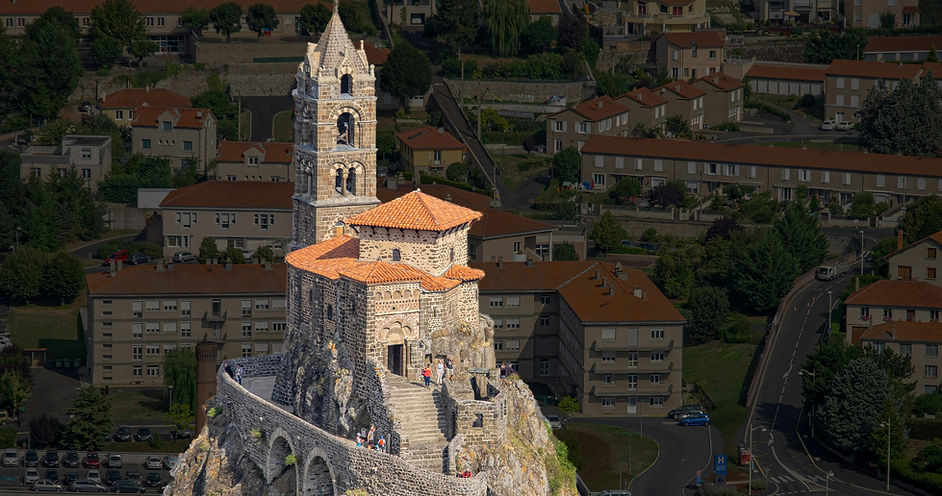
Le Puy isn't just a point of departure!
It's a breathtaking sight on its own, renowned for its picturesque location amidst volcanic summits
and its magnificent cathedral, designated as a UNESCO
World Heritage site.
2. When is a good time to walk this route?
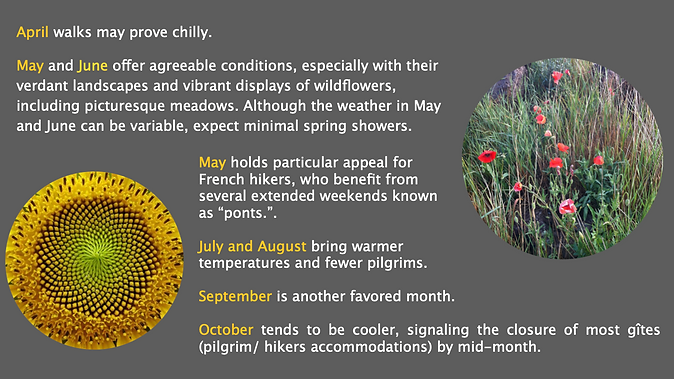
-
Generally, the walking season commences in April and ends mid-October.
-
The most popular months for walking the VP :
May, June,and September
We don't recommend walking in winter (Nov to the end of March), not unless you have the experience of members of
certain Alpine regiments!
It may present challenges due to inclement weather conditions, such as snow on the Aubrac plateau, and a scarcity of open gîtes.

3. How long does it take to walk ?
The duration of the walk along the trail varies depending on your pace.
Those moving at a slower pace (2-3 km/h or 1-2 mph), typically cover approximately 12-15 km over six hours. At this rate, it would take around 50 days to reach SJPdP.
A medium-paced walker, averaging 3-4 km/h (2-2.5 mph), typically covers about 15 to 24 km per day. Consequently, it would take around 35 days to complete the journey to SJPdP at this pace.
For those opting for a faster pace, around 4-5 km/h or 2.5-3 mph, they can cover 24-30 km per day.
This quicker tempo allows them to reach SJPdP in approximately 25-30 days.

Most people walk
about 6 hours per day
and complete the Via Podiensis
in around 32 to 35 days
which is an average of
21 to 25 kms a day.
4. Is it a difficult walk? Do I need to be very fit?

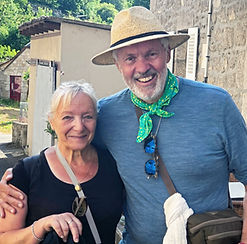

Many people of various ages and fitness levels successfully complete the Via Podiensis each year.
This Camino route involves walking through diverse terrain including hills, mountains, valleys, and rural areas.
Some sections can be challenging due to steep inclines or rough terrain but nothing is out of limits, even for a beginner.
You don't need to be an elite athlete, but it is, of course, advisable to be in good physical condition before embarking on any long-distance hike.

5. I’m in my 50s, 60s, 70s, 80s…is it not too difficult for me?
The difficulty of walking the Le Puy route depends on several factors such as your physical condition, hiking experience, and the pace at which you choose to walk.
Over the 10 years we’ve supervised our Facebook group dedicated to the Le Puy route, we’ve seen individuals of all ages, including people in their 50s, 60s, 70s, and even 80s, successfully complete the route.
It is not a “technical” hike but there are a few hills to walk up and down. Probably the most difficult days are the second and third. Anybody can do it with proper preparation, pacing and rest.
You will get more and more fit as you walk.
What some of our senior members are saying.
"I did the Le Puy route with temperatures in the 30s.
There are climbs , but nothing technical. Just take your time and pack extra water. The views are well worth it!"

Dave, in his late 70s
Wanda, one of our “Elders” (88) in our Fb group
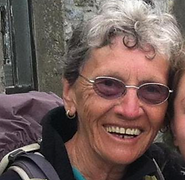
"walked the Le Puy route to Santiago twice in 2022 and 2023 (and will be walking in 2025).
There are some decent ascents/descents – with lots of rocks – but it is so beautiful!
In 2023 I turned 86, but I did not have any problems other than sometimes, going up, I had to stop and breathe!
If I can do it, you can too."
6. How do I train for walking the Le Puy route?
Getting ready to trek the Le Puy route, celebrated for its diverse landscapes, requires a multifaceted approach to meet the journey's physical demands.
Here are a few examples of things you can do to get fit for Le Puy!
-
Walk every day: Even if it’s just for 1 hour. Get your body in the habit of walking.
-
Cardio exercises: Running, cycling, or swimming to improve cardiovascular
endurance.
-
HIIT: (High-Intensity Interval Training): Enhances cardiovascular fitness and muscular strength.
-
Stretching routines: Aid in flexibility, preventing injuries and promoting better range of motion.
-
Walking up and down stairs: Simulates varied terrain, builds leg strength, and improves balance.
-
Backward walking: Enhances proprioception and strengthens muscles
Getting ready is also about getting the right equipment (footwear, moisture-wicking-clothing and a well-fitted backpack with manageable weight
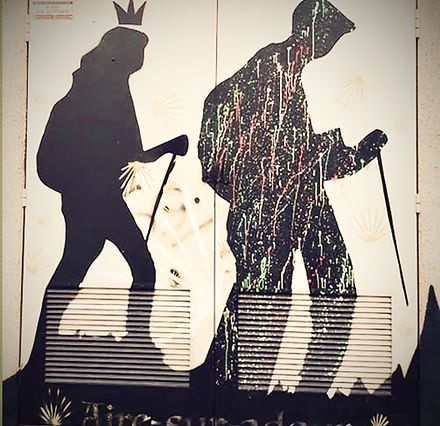
Useful advice to prepare your bag !
"When you have collected the things you plan to take, ask of each of them: "Is that there to insulate me from what the journey has in store?" If it is, leave it behind."
Charles Foster, "The Sacred Journey"
7. How do I get to Le Puy?
Landing in Paris?
From Paris Charles de Gaulle Airport (CDG) to Le Puy-en-Velay

Sounds complicated?
It really isn’t!
The connection at St Etienne is very easy:
you literally hop off the train , cross the platform where your train to Le Puy will be waiting for you (or arriving very soon).
From Paris city (Gare de Lyon) to Le Puy-en-Velay, you have 2 options.

Why choose the second option when the first one is “more direct”?
Because there are a LOT more trains going from Paris to Lyon than directs to St-Etienne.
Landing in Lyon?
Take the “Rhône Express shuttle” !
The “Rhône Express” takes 30 min from the airport to Lyon Part-Dieu train station.
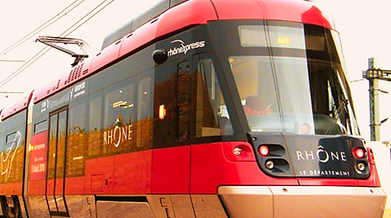
Then, from Lyon Part-Dieu ,
you’ll take a regional train to Saint-Etienne and then another regional train from St- Etienne
to Le Puy-en-Velay.
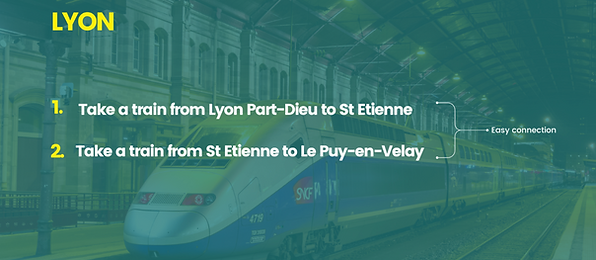
Sites we recommend for planning your trip and/or buying your tickets:
-
Rome2rio (www.rome2rio.com)
-
Trainline (www.trainline.com)
-
SNCF (www.sncf.com)
-
The man in seat 61 (www.seat61.com)
8. How do I navigate the way?
You rely on the way marking system of Blazes, White and Red stripes, to guide you.
The system used for the GR 65 can be aptly summed up in two words: EASY and EXCELLENT,
All thanks to the dedicated efforts of volunteers, the marking for the GR 65 is “practically perfect”.

It’s so reliable that you can trust, in most circumstances and on most days, that you won't stray off course.
It uses white and red stripes, easily identifiable.
It’s so reliable that you can trust, in most circumstances and on most days, that you won't stray off course.
If you do happen to veer off track, it's often due to being lost in thought or engrossed in conversation with a fellow pilgrim, causing you to overlook a blaze.



These stripes are consistently spaced along the route and can manifest as painted marks, plastic signs, or strips of electrical tape.
Where GR routes intersect, you will generally find a sign post, another marker to give you more information.

Turn left
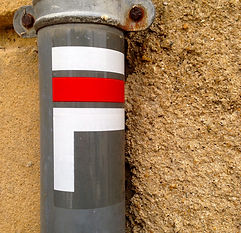
Turn right
Right path out of Varaire

Wrong way
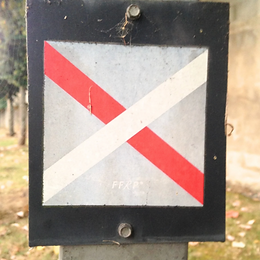
Where GR routes intersect, you will generally find a sign post, another marker to give you more information.
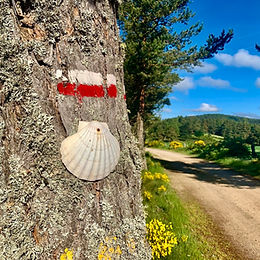


9. SLEEPING ON THE CAMINO - Gîtes: your home away from home
Gîtes are typically where you’ll be staying at night while walking the Camino.If you're picturing a simple albergue or hostel, think again. Think more along the lines of a cozy bed and breakfast, often with the option of a delightful dinner.
Gîtes come in various forms, primarily municipal, private, and parochial.
-Municipal gîtes are managed by local municipalities, typically offering budget-friendly options. While some lack dinner services, others provide communal kitchens for self-catering. Many boast charming settings, such as historic buildings with stunning views
-Privately owned gîtes are former houses or apartments transformed to cater to pilgrims. Run by dedicated people who are often former pilgrims themselves, these accommodations prioritize understanding and meeting the needs of fellow travelers.
-Parochial gîtes, located near religious sites like abbeys, they offer unique experiences.

This communal gîte is in a tower from the 14th century,
in Aubrac.It was built to defend against the English during the Hundred Years' War.
A private gîte in a typical Basque house.
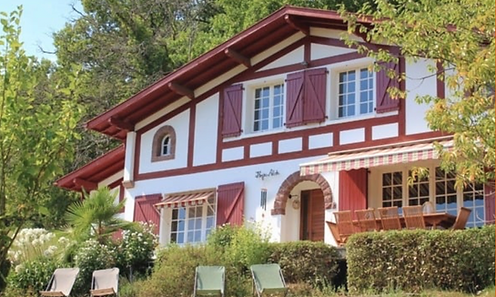
Are there any private rooms in gîtes?
Yes, many places have at least 1 private room.
Do they have bed linen?
Many, but not all, offer bed linen for a few extra euros.
What time do gîtes open ?
Around 3 to 4 PM.
How do I communicate with the gîtes?
Through email, text message or direct call.
Many gîtes have WhatsApp.
Do I need to book my gîtes in advance?
See the page about booking.

It's in gîtes where you'll find
the Camino spirit!
Not every gîte may be exceptional, most offer a valuable and memorable experience intrinsic to the Camino. It's akin to staying with a French family, sharing a home-cooked meal prepared with care and often featuring local ingredients.
10. Do I need to book my gîte in advance? How far in advance and,
how do I do this?
When planning your pilgrimage, it's natural to worry about finding accommodation along the way.
Especially if you come from a country far away and have no experience of walking in France and/or on the camino.
Worries about busy months, specific requirements, or even the availability of dinner at the gîtes can loom large. However, we urge you to resist the urge to lock yourself into a rigid itinerary by booking everything in advance.
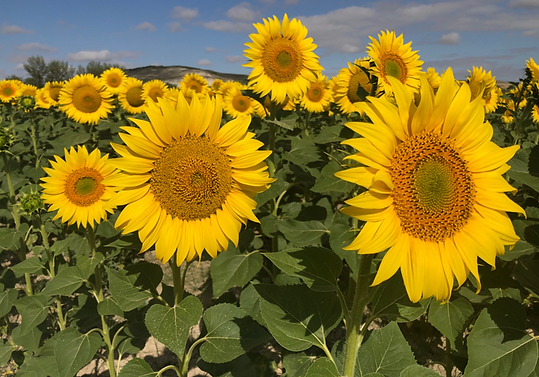
Our advice:
Book the first 5 nights and then book 2-3 nights ahead as you go along.
In May, because it's the busiest month, you can book up to Conques.
A tip?
Start your pilgrimage mid-week from Le Puy.
The Camino is all about embracing the unexpected.
No matter how meticulously you plan, you can't insulate yourself from the twists and turns of the journey. From unforeseen injuries to chance encounters with a "Camino family" you're reluctant to leave behind, the path ahead is full of surprises.
Flexibility is key on the Camino.
Adapt your booking strategy to match your pace and preferences as you walk. Explore communal gîtes, which offer unique experiences and often have space available even when private accommodations are full. Remember, the more requirements you have, the harder it becomes to secure a spot—so stay open, stay flexible, and let the journey unfold as it may.
11. Rob’s guide to the Via Podiensis and variants
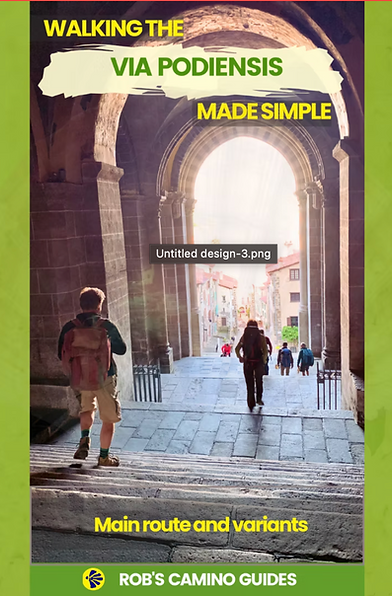
"Your Camino made simple."
Rob's guide is packed with 87 pages of visually clear, reliable information, built from over 11 years of experience creating trusted resources for pilgrims.
We promise it will not only guide you but inspire you, deepening your connection with the path and the incredible people you’ll meet along the way.
As seasoned pilgrims who have walked this route both alone and together, as well as many other Caminos, we’ve poured our hearts into every detail of this guide.
Our promise is simple
We’re here to help you embrace the true spirit of the Camino—focusing on what truly matters: the unforgettable journey and the life-changing connections you’ll make.
We’ve taken care of the logistics so you can dive into the magic, adventure, and camaraderie of the pilgrimage.
The Key Features in our 2025 guide
-
Comprehensive maps - Clear route markings with variants and points of interest
-
Visual elevation profiles - See at a glance how challenging each day will be
-
Intuitive icons - Quick identification of all services from pharmacies to restaurants
-
Overview blocks - At-a-glance information about communities, distances, and services
-
Detailed gîte information - Complete, up-to-date listings of all accommodations with prices and amenities
-
Navigation assistance - Town exit maps to guide you through potentially confusing sections
-
Route variants - Detailed information on alternatives like the Célé Valley and Rocamadour
-
Interactive links - Simply tap any gîte name (shown in blue) to visit their website instantly
-
WhatsApp compatibility - Green phone numbers indicate WhatsApp availability for intl communication
-
Portable PDF format - Plan at home on your computer, then take the guide with you on your phone
Want to know what’s inside Rob’s guide and why readers love it?
Click here to explore—and grab your copy if it feels like a fit.
12. Are there services on the Way?
YES!
There are services all along the way but may not be precisely where you are when you need them.
Check out where the services are in Rob’s guide and also consider the opening hours which may be quite different to what you are used to!
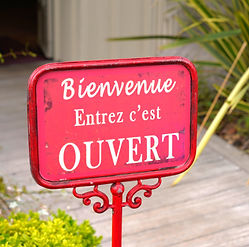
Most shops are open at least from Tuesday to Saturday.
Almost all close for a 2 to 3 hour midday break.
The traditional closing day is Sunday.
Small businesses also often close on Monday
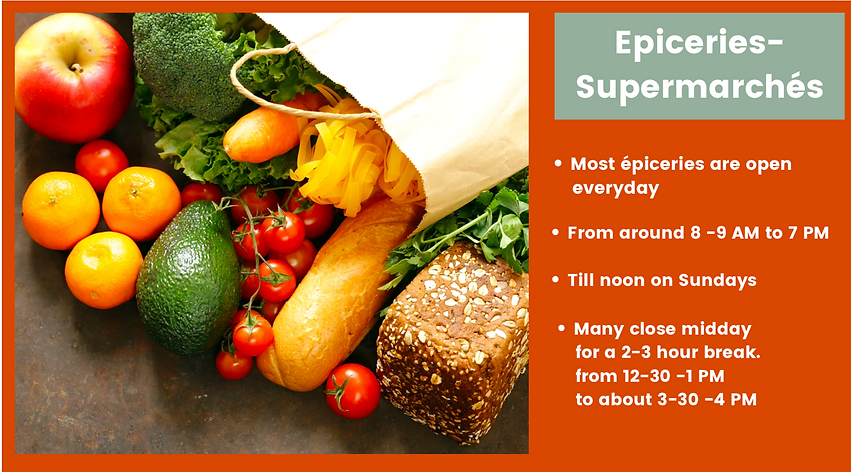



13. How about water ?
Potable water can be easily found along the way.
Of course, you can also buy bottles from supermarkets.
France is renowned for the quality of its bottled water.
The country boasts a diverse range of natural springs and mineral-rich aquifers, which contribute to the production of high-quality bottled water.

Tip !
Cemeteries are a good place to find water because people leave flowers and fill containers with water there, making it a reliable spot for drinking water
Additionally, you can use the FreeTaps app for assistance.
14. How do I pay for things?
The Camino is still very much a cash economy even if there are more and more places that accept Credit/Debit cards.
Always make sure to have around 400-500 Euros with you.
There are sufficient Cash dispensers for you to top up as you go along. See Rob’s guide to find out where they are.
15. How expensive is it to walk the route?
The average is about 50 to 60 euros per person and per day.
This includes the Demi-Pension (DP ) of about 40-45 euros for B&B and dinner, plus 10/15 euros for the rest of the day.
Of course you may also do a little self catering which can significantly reduce the overall price of your camino. Check out in Rob’s guide the gites that offer this possibility.
Depending on how much time you need to complete it, if you self-cater or go for the “demi-pension” (B&B + dinner), you cami will cost anything between:
1,200 euros (35/day, self catering for 32 days) and 2,000 euros (60 euros a day, doing “demi-pension”).
16. Are there any bag transportation services?
Three companies offer baggage transportation services along the Via Podiensis.
La Malle Postale
provides service between Le Puy-en-Velay and Lectoure, and also serves the Célé Valley and Rocamadour variants, between April and October.
Click the link : La Malle Postale
Transports Claudine
operates between Conques and Saint-Jean-Pied-de-Port, as well as on the Célé Valley variant, from April through October.
Click the link: Transports Claudine
Les Valises de Saint-Jacques
runs from late March to early November, between Moissac and Saint-Jean-Pied-de-Port
Compost’elle Bus
runs from late March to early November, between Moissac and Saint-Jean-Pied-de-Port Click the link : Compostelle Bus
17. Do I need to speak French?
While speaking French can certainly enhance your experience walking the Via Podiensis, it's not a requirement. Many pilgrims navigate the route successfully with minimal to no French language skills.
The French really appreciate visitors/pilgrims who make an effort with the language. They tend to treat them with more warmth.
While you can get by in English, there will be places and instances where you may encounter individuals who speak none at all—and this can pose challenges.
Learning some basic French phrases can be beneficial for everyday interactions, such as ordering food or asking for directions.
It can also help you feel more confident and comfortable during your journey.
If you're interested in improving your French skills before your trip, there are various resources available, including language courses and online tutorials.

......................
Regardless of your language abilities, maintaining an open mind and a willingness to engage with locals will enrich your pilgrimage experience along the Camino.
Walk the Camino through France with confidence and connection.
We're happy to share a down-to-earth French course, created by a native speaker and fellow traveler, made with pilgrims in mind.
Learn the language for everyday moments—booking gîtes, ordering meals, asking directions, and navigating the unexpected.
Go beyond basic phrases to speak with ease, warmth, and authenticity—making meaningful connections along the Way.
To find out more, click here:
18. Do I need to a pilgrim passport?
Unlike in Spain, a pilgrim passport (called Créantiale or Crédentiale) is rarely needed on the Way in France to access pilgrim accommodation.
However, if you're walking all the way to Santiago, you'll want to get your hands on a pilgrim passport.

Throughout your pilgrimage, don't forget to get your passport stamped at each stop along the way, whether you're staying overnight or passing through a village (ask in churches, cafés, restaurants, tourist offices…)
These stamps serve as proof of your journey and are especially important when you arrive in Santiago de Compostela. They're needed to obtain the "Compostela," a certificate given to pilgrims upon reaching Santiago. This document, written in Latin and issued by the pilgrim office is a symbolic milestone of your pilgrimage.
You can buy this Créanciale in the Cathedral shop in the le Puy Cathedral...
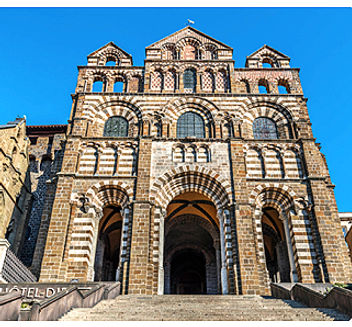
19. A cultural and culinary odyssey
The Via Podiensis isn't just a pilgrimage; it's a culinary odyssey.
Each region you traverse boasts its own gastronomic treasures. Picture indulging in creamy aligot in Aubrac, relishing the savory depths of duck confit in Gascony, and sipping on the renowned Cahors wine. It's a voyage that delights the senses as much as it dazzles the eyes.
Just a few examples
Les lentilles du Puy, l’aligot et le thé de l’Aubrac, le fromage de Laguiole, les truffes de Lalbenque, le vin de Cahors, le chasselas de Moissac,
le pastis gascon et l’Armagnac d’Eauze, les spécialités à base de canard dans le Sud-Ouest, le vin d’Irouleguy.

Les Lentilles du Puy

l'Aligot de l'Aubrac

Le fromage de Laguiole

le vin de Cahors

Truffes de Lalbenque

Chasselas de Moissac
20. Market Days?
One of the great things about France are all the weekly markets held in many of towns and villages along the le Puy route. They sell all kinds of amazing, fresh food and produce, and are a feast for the senses.Here’s a list of all the towns with markets and when they’re held:



21. How Safe is it and for Women?
The Chemin du Puy-en-Velay is a very safe place and equally so for women.
There are many solo-women who walk the chemin.
22. Camping?
France is a very camping-friendly country. On the via Podiensis there are many campgrounds and gîtes too, where you can pitch a tent -see Rob’s Guide for a comprehensive listing. Wild-camping (“le camping sauvage”) is also permitted beside or near roads, and on public land (some restrictions might be in place). On private land you will need you will need the permission of the tenant or owner. See this link for full details: https://rural-camping.com/france/wild-camping.htm
